You know those moments when you taste something for the first time and think "Nope, not for me!" – but then end up craving it like crazy? That's exactly what happened with this Sambal Chicken during my food adventures in Malaysia.
I first stumbled upon it at a bustling Mamak stall in Kuala Lumpur, and honestly, the spice level nearly knocked me out. But there was something about that crispy coating, the juicy meat, and that complex, spicy-sweet-tangy sauce that kept calling me back.
Before I knew it, I was stopping by that same stall every other day, always ordering my Sambal Chicken with two pieces of roti canai (those flaky, buttery flatbreads that are basically heaven on a plate).
Now that I'm back home, I've recreated the recipe with a few tweaks – swapping hard-to-find belacan with our trusty bagoong and dried hibi. It's so close to the original that one bite will transport you straight to those lively streets of Kuala Lumpur.
Jump to:
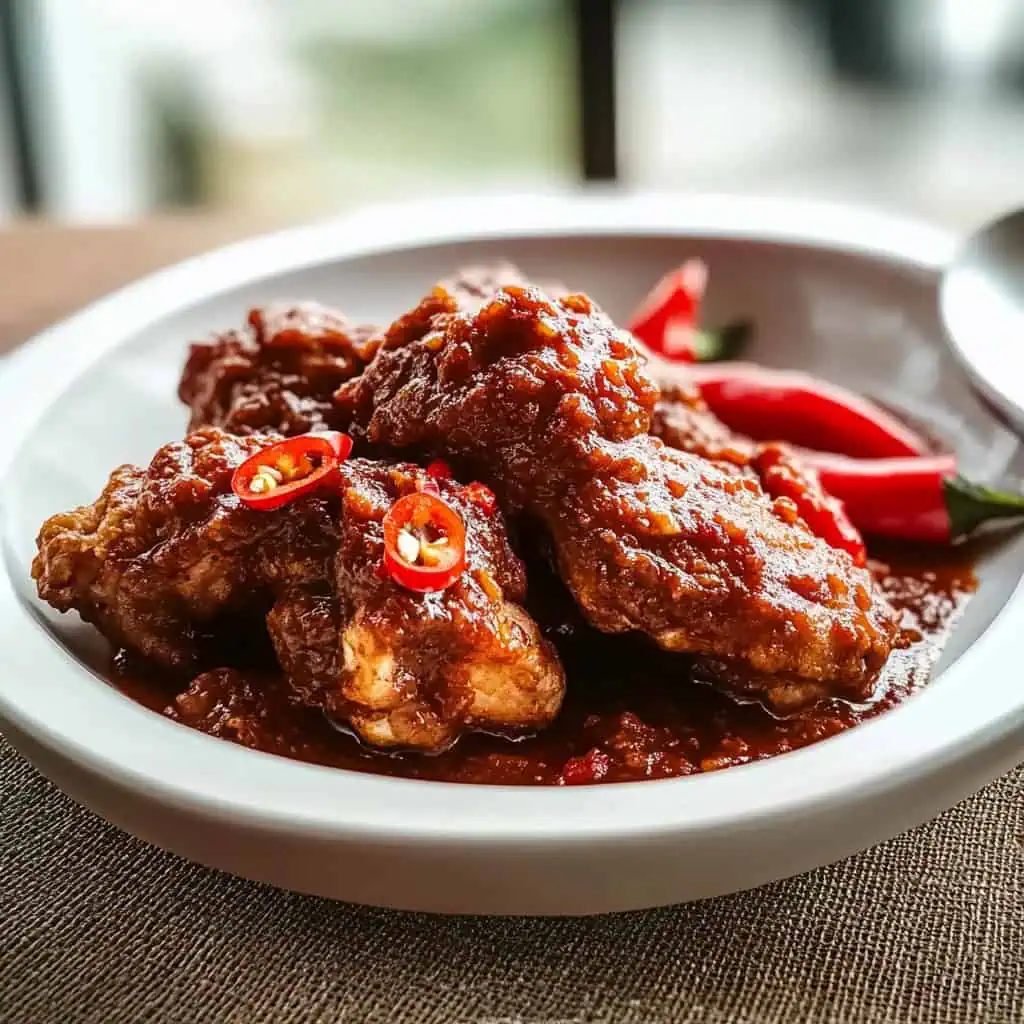
Why You'll Love This Recipe
- Perfect Texture: Achieve that signature crispy exterior while maintaining juicy, tender meat inside
- Authentic Flavors: Experience the genuine taste of Malaysian street food at home
- Customizable Heat: Easily adjust the spice level to suit your preference
- Make-Ahead Friendly: The sambal sauce can be prepared in advance
- Restaurant Quality: Recreate the famous Mamak stall experience in your kitchen
Ingredients
This authentic Malaysian Sambal Chicken relies on carefully selected ingredients that create layers of flavor and texture. Chicken thighs provide juiciness that stands up to high-heat frying, while tapioca flour creates that signature light, crispy coating. The sambal's complexity comes from the umami-rich combination of bagoong and dried shrimp, balanced by the aromatics of shallots, garlic, and ginger.
The chilies deliver customizable heat, while lemongrass adds a distinct citrusy note. Tamarind introduces the essential tangy element, and the final addition of fresh tomatoes and onions brings brightness to the rich sauce.
Each ingredient plays a crucial role in achieving the perfect harmony of spicy, sweet, sour, and savory flavors that makes this dish irresistible.

For the Chicken:
- 1 kg chicken thighs, cut into bite-sized pieces
- Salt
- Freshly ground black pepper
- 3 egg whites
- 1½ cups tapioca flour (cassava flour)
For the Sambal Sauce:
- 2 tablespoons bagoong (fermented shrimp paste)
- ⅓ cup dried shrimp, ground to powder
- 6 shallots
- 6 cloves garlic
- 1-inch fresh ginger, sliced
- 6 long red chilies
- 3 bird's eye chilies
- 1 stalk lemongrass, white part only
- 1 tablespoon tamarind pulp
Additional Ingredients:
- 4 tomatoes, chunked
- 1 large onion, chunked
- 3 tablespoons tomato sauce
- ½ cup chicken stock
- 1 tablespoon sugar
- Oil for deep frying
Equipment
- Wok or large deep frying pan: Essential for both deep frying the chicken and preparing the flavorful sambal sauce
- Food processor or blender: Creates a smooth, well-integrated sambal paste from multiple ingredients
- Deep fry thermometer: Ensures precise oil temperature for achieving the perfect crispy coating
- Spider strainer or slotted spoon: Allows safe extraction of fried chicken pieces while draining excess oil
- Heavy-bottom pan: Provides even heat distribution when preparing the complex sambal sauce
- Cutting board and sharp knife: For precise preparation of chicken and aromatics
- Mixing bowls: Used for marinating chicken and preparing ingredients
- Measuring cups and spoons: Ensures accuracy in ingredient proportions
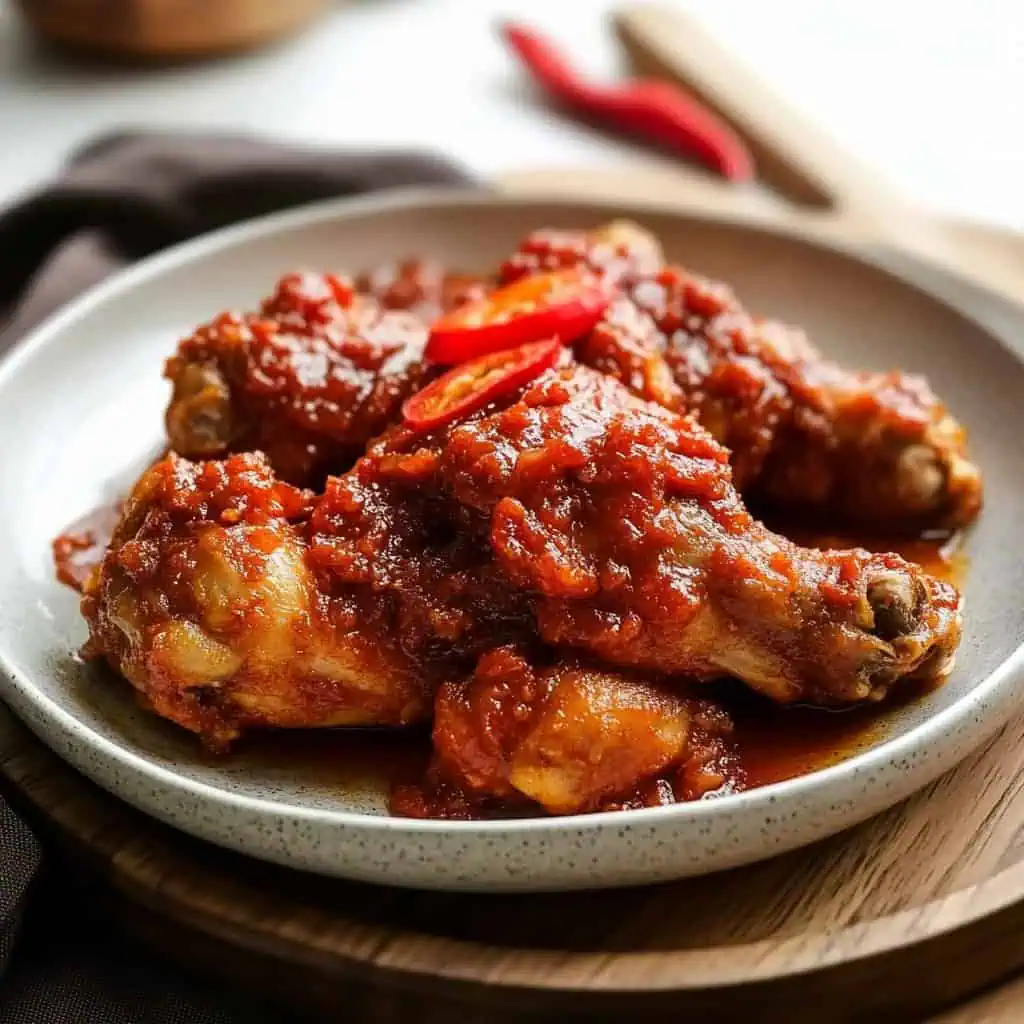
How To Make
- Cut chicken thighs into bite-sized pieces, about 2 inches each. Place in a bowl and season with salt and pepper. Add the egg whites and mix thoroughly with your hands. Let sit at room temperature for 15 minutes while preparing remaining ingredients.
- Prepare the sambal paste by combining bagoong, ground dried shrimp, shallots, garlic, ginger, red chilies, bird's eye chilies, lemongrass, and tamarind pulp in a food processor. Blend until smooth, stopping occasionally to scrape down the sides for uniform consistency.
- Prepare for frying by filling a wok or deep pan with approximately 3 inches of oil. Heat to 180°C (350°F). If without a thermometer, test by dropping a small piece of flour in the oil - it should sizzle gently and float to the surface.
- Place tapioca flour on a plate. Coat each marinated chicken piece completely in flour. When oil reaches proper temperature, fry chicken in small batches to avoid overcrowding. Fry for approximately 10 minutes until golden brown. Remove and drain on paper towels.
- For the sauce, pour out most of the oil from the wok, leaving about 3 tablespoons. Heat to medium and add the sambal paste. Cook while stirring until fragrant and the oil separates from the paste, approximately 5 minutes.
- Add tomato sauce, sugar, chopped onions, and chicken stock to the sambal. Increase heat to high and cook for 2 minutes, stirring constantly to prevent burning.
- Return fried chicken pieces to the wok and add chopped tomatoes. Gently stir to coat chicken evenly with sauce. For additional sauce, add water incrementally until desired consistency is achieved. Bring to a quick boil, then immediately remove from heat.
- Serve hot with freshly steamed rice. The crispy chicken should be generously coated with the spicy-sweet sauce, delivering perfect flavor balance in every bite.

Tips from Lola's Kitchen
- Choose the right cut: Always use chicken thighs instead of breast for juicier, more flavorful results. The higher fat content in thighs prevents the meat from drying out during frying.
- Perfect the marinade: Don't skip the egg white marinade - it creates a protein barrier that helps retain moisture and creates the signature crispy coating when combined with tapioca flour.
- Enhance aromatic depth: Toast the dried shrimp in a dry pan before grinding to powder. This quick step develops a deeper, more complex flavor profile in your sambal sauce.
- Master the spice level: Adjust the number and type of chilies based on your heat preference. Remember that bird's eye chilies pack significant heat, so adjust accordingly.
- Achieve authentic flavor: Let the sambal paste cook until the oil separates (known as "pecah minyak" in Malaysia). This indicates the aromatics have fully released their flavors and the paste has properly caramelized.
- Maintain crispiness: For maximum crispiness, don't sauce all the chicken at once if serving a larger group. Keep some chicken separate and add sauce just before serving each portion.
Substitutions
- Bagoong → Shrimp paste (belacan): Belacan is traditional but harder to find outside Southeast Asia. Bagoong provides a similar fermented seafood depth.
- Tapioca flour → Cornstarch or potato starch: While tapioca flour creates the ideal texture, cornstarch (50%) mixed with all-purpose flour (50%) works well in a pinch.
- Fresh chilies → Chili paste: Substitute with 2-3 tablespoons of sambal oelek or sriracha if fresh chilies aren't available.
- Lemongrass → Lemon zest + ginger: Combine 1 teaspoon lemon zest with extra ½ teaspoon ginger for a reasonable approximation of lemongrass's citrusy complexity.
- Tamarind → Lime juice + brown sugar: Mix 2 teaspoons lime juice with 1 teaspoon brown sugar to mimic tamarind's sweet-sour profile.
Troubleshooting
Chicken not crispy enough?
- Ensure oil temperature reaches and maintains 180°C (350°F) throughout frying
- Fry in smaller batches to prevent oil temperature from dropping significantly
- Make sure chicken pieces are at room temperature before frying
- Check that egg white coating is thorough before dredging in tapioca flour
Sauce too thick or thin?
- If too thick: Add chicken stock one tablespoon at a time while stirring constantly
- If too thin: Simmer longer to reduce liquid content, or add a small cornstarch slurry (1 teaspoon cornstarch dissolved in 1 tablespoon water)
Not spicy enough?
- Add more bird's eye chilies to the sambal paste
- Incorporate 1-2 teaspoons of sambal oelek or chili paste at the sauce stage
- Serve with fresh sliced chilies on the side for individual heat adjustment
Sambal tastes bitter?
- Reduce cooking time for the chilies in the paste
- Remove seeds from chilies before blending
- Balance with additional sugar (½ teaspoon at a time)
Storage & Reheating
- Refrigeration: Store in an airtight container in the refrigerator for up to 3 days. For best results, keep chicken and sauce separately.
- Freezing: The uncoated, marinated chicken can be frozen for up to 3 months. The prepared sambal sauce can be frozen in ice cube trays for portioned use for up to 2 months.
- Reheating fried chicken: Place in a 180°C (350°F) oven for 10-15 minutes to restore crispiness. Avoid microwave reheating as it will make the coating soggy.
- Sambal sauce storage: Store prepared sambal sauce separately in the refrigerator for up to 1 week. It actually improves in flavor after 24 hours as the ingredients meld.
- Make-ahead strategy: Prepare the sambal sauce up to 3 days ahead and store refrigerated. Fry the chicken fresh on the day of serving for optimal texture.
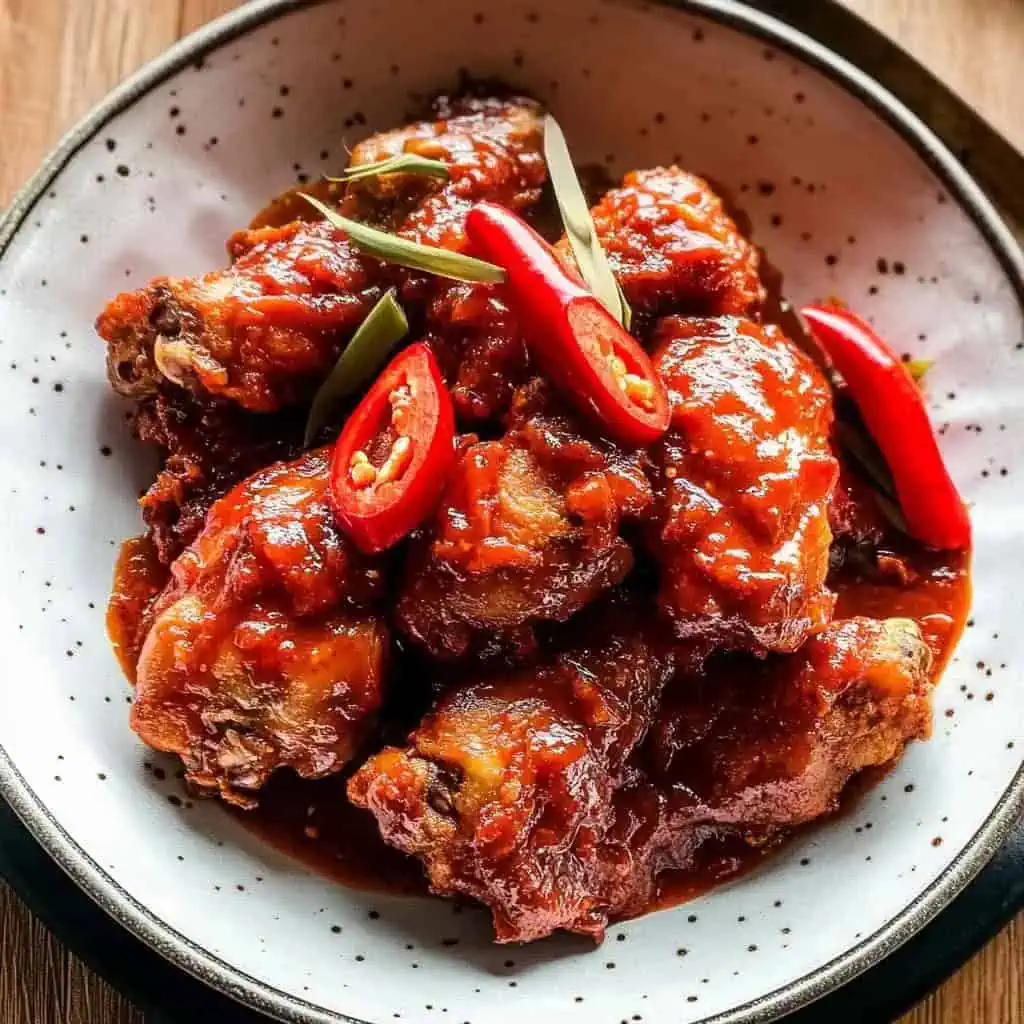
FAQ
Can I make this less spicy?
Yes, reduce or omit the bird's eye chilies and use mild red chilies instead. You can also remove the seeds and membranes from the chilies to significantly reduce heat while maintaining flavor.
Can I prepare the sambal sauce in advance?
Absolutely! The sauce can be made up to 5 days ahead and stored in the refrigerator. In fact, making it 1-2 days in advance allows the flavors to develop more fully.
Why use tapioca flour instead of regular flour?
Tapioca flour creates a lighter, crispier coating that stays crunchy longer, even after being sauced. It also provides a distinctive texture that's authentic to Malaysian cuisine.
Can I use chicken breast instead of thighs?
Yes, but reduce cooking time to 8 minutes to prevent drying. Chicken breast should be cut into slightly larger pieces and marinated for 30 minutes (instead of 15) to help retain moisture.
Is this dish gluten-free?
Yes, when using pure tapioca flour and ensuring your bagoong and sauces are gluten-free. Always check labels as some processed ingredients may contain hidden gluten.
Can I bake the chicken instead of frying?
While not traditional, you can bake the coated chicken pieces at 220°C (425°F) for about 20 minutes, turning halfway. Spray or brush lightly with oil first for better browning.
What's the best way to grind dried shrimp?
For best results, toast dried shrimp in a dry pan until fragrant, then cool completely before pulsing in a spice grinder or food processor until a fine powder forms.
How can I make this dish ahead for a party?
Prepare the sambal sauce and fry the chicken up to 3 hours ahead. Keep the chicken uncovered at room temperature, then reheat in a 180°C (350°F) oven for 5-7 minutes before tossing with reheated sauce just before serving.
Related
Looking for other recipes like this? Try these:
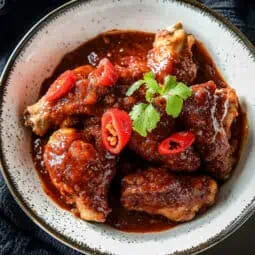
Sambal Chicken (Ayam Sambal)
Equipment
- Wok or large deep frying pan (for deep frying and sauce preparation)
- Food processor or blender (for making sambal paste)
- Deep fry thermometer (for precise oil temperature)
- Spider strainer or slotted spoon (for safe frying)
- Heavy-bottom pan (for sauce preparation)
- Cutting board and sharp knife
- Mixing bowls (for marination)
- Measuring cups and spoons
Ingredients
For the Chicken (Para sa Manok)
- 1 kg chicken thighs cut into bite-sized pieces (manok na hita, hiniwa)
- Salt asin
- Freshly ground black pepper dinurog na paminta
- 3 egg whites puti ng itlog
- 1½ cups tapioca flour cassava flour/galapong ng kamoteng kahoy
For the Sambal Sauce (Para sa Sarsang Sambal)
- 2 tablespoons bagoong fermented shrimp paste
- ⅓ cup dried shrimp ground to powder (giniling na hibi)
- 6 pieces shallots sibuyas tagalog
- 6 cloves garlic bawang
- 1- inch fresh ginger sliced (luya)
- 6 pieces long red chilies siling haba
- 3 pieces bird's eye chilies siling labuyo
- 1 stalk lemongrass white part only (tanglad)
- 1 tablespoon tamarind pulp sampalok
Additional Ingredients
- 4 pieces tomatoes chunked (kamatis)
- 1 large onion chunked (sibuyas)
- 3 tablespoons tomato sauce sarsa ng kamatis
- ½ cup chicken stock sabaw ng manok
- 1 tablespoon sugar asukal
- Oil for deep frying mantika
Instructions
- Start by cutting your chicken thighs into bite-sized pieces, about 2 inches each. Put them in a bowl and season with salt and pepper. Add the egg whites and mix well with your hands. Let this sit at room temperature for 15 minutes while you prepare the rest of your ingredients.
- Meanwhile, make your sambal paste. Put all of these in your food processor: bagoong, ground dried shrimp, shallots, garlic, ginger, red chilies, bird's eye chilies, lemongrass, and tamarind pulp. Blend everything until you get a smooth paste. If needed, stop and scrape down the sides of the processor to make sure everything is well blended.
- Get your wok or deep pan ready for frying. Fill it with enough oil for deep frying - about 3 inches deep. Heat the oil to 180°C (350°F). If you don't have a thermometer, test by dropping a small piece of flour in the oil - it should sizzle gently and float to the top.
- Put your tapioca flour on a plate. Take your marinated chicken pieces and coat them one by one in the flour. Make sure each piece is completely covered. When your oil is hot, fry the chicken in small batches - don't overcrowd the pan. Fry for about 10 minutes until golden brown. Take them out and place on paper towels to drain.
- Now for the sauce. Pour out most of the oil from your wok, leaving just about 3 tablespoons. Turn the heat to medium and add your sambal paste. Cook it while stirring until it becomes really fragrant and you can see the oil separating from the paste - this takes about 5 minutes.
- Add the tomato sauce, sugar, chopped onions, and chicken stock to the sambal. Turn up the heat to high and cook for 2 minutes, stirring the whole time so nothing burns.
- Put your fried chicken pieces back in the wok and add the chopped tomatoes. Gently stir everything together so the chicken gets nicely coated with the sauce. If you want more sauce, just add a little water until it looks right to you. Let it come to a quick boil, then turn off the heat right away.
- Serve your sambal chicken hot with freshly steamed rice. The crispy chicken should be nicely coated with the spicy-sweet sauce, and every bite should have that perfect balance of flavors.
Tips from Lola's Kitchen
- Use chicken thighs instead of breast for juicier results
- Don't skip the egg white marinade - it helps create the signature crispy coating
- Toast the dried shrimp before grinding for enhanced flavor
- Adjust the number of chilies based on your spice preference
- Let the sambal paste cook until the oil separates for best flavor
Nutrition
The Story Behind Sambal Chicken
Sambal Chicken, known locally as Ayam Sambal, stands as a testament to Malaysia's rich culinary heritage where Chinese cooking techniques meet Malay spice traditions. This beloved dish emerged from the bustling streets of Malaysia's Mamak stalls, where Indian Muslim vendors created a perfect fusion of crispy fried chicken and the iconic sambal sauce that defines Malaysian cuisine.
The heart of this dish lies in its sambal sauce, a cornerstone of Malaysian cooking that dates back centuries. Traditional recipes call for belacan (fermented shrimp paste), a ingredient that traveled ancient maritime spice routes from coastal fishing villages to urban centers. This crucial component gives the dish its distinctive umami depth that pairs perfectly with the crispy chicken exterior and juicy meat within.
In Malaysian households, Ayam Sambal frequently appears during family gatherings and festive celebrations, particularly during Hari Raya and Chinese New Year. The dish showcases the beautiful cultural amalgamation that defines Malaysian food – the Chinese technique of coating and frying meets the Malay art of sambal-making, while Indian influences show in the complex layering of spices.
Today, you'll find this dish everywhere from humble street stalls to high-end restaurants in Kuala Lumpur, Penang, and Johor Bahru. Each region adds its own twist – Penang versions tend to be spicier, while southern preparations often include more sweet and sour notes. The beauty of Sambal Chicken lies in its adaptability; home cooks across Southeast Asia have embraced and modified it to suit local tastes and available ingredients.
Modern interpretations of Sambal Chicken have evolved to include various cooking methods and presentations, but the essence remains unchanged – crispy chicken pieces generously coated in that addictively spicy, sweet, and tangy sambal sauce. This recipe stays true to the authentic Malaysian street food experience while making thoughtful substitutions for hard-to-find ingredients, ensuring you can recreate this iconic dish in your own kitchen.









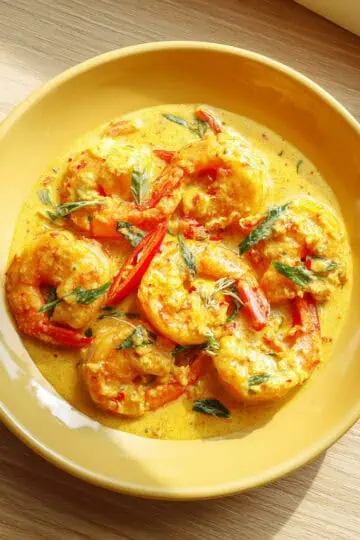
Comments
No Comments